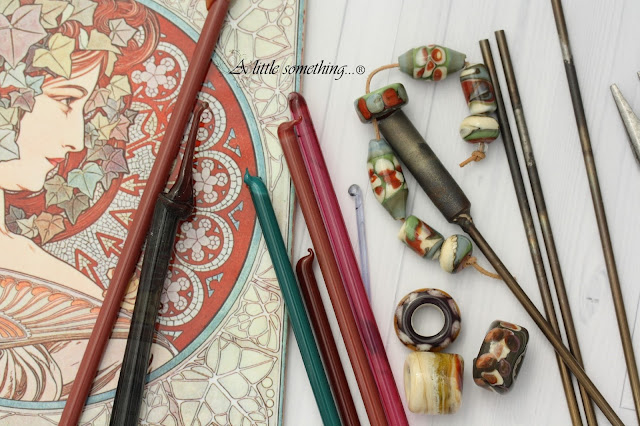When I began creating jewelry, the elements combined came from something with a previous life - a tarnished choker, a single lost earring, notions from an antique estate. I would disassemble them with utmost care and salvage bits of chain, beads and charms, so when resurrected, the next incarnation could be original with my special touch. I developed Deux-coupage ® so that my craft would be unique, pairing pretty images with intricate reworked chain-links and beads. Like any artist, I always want to make more. So, I enrolled in class and began to learn lampworking. Now I have the ability to create one-of-a-kind glass beads replacing ones I used to buy. Colors are chosen to coordinate with the images and elements, and somehow I work magic one piece at a time.
Lampworking is melting glass in an open flame, thus the name flameworked glass. This method has been practiced in Murano, Italy since the 14th century. Beads are created on steel rods, or mandrels, that are coated in a special resist so the molten glass sticks to form a bead, but also once cooled can be removed. There are numerous sizes and shapes of mandrels. Wider diameter mandrels are used for donut-shaped beads, rings, and free-form pendants.
Inspiration comes from different sources. When creating trend boards for Trend Spotlight, I collect current concepts from the runway for color and pattern. Many times, sketching ideas for necklaces in various assemblage are part of the initial process. Influences are also found in magazines and Pinterest.
Mood boards serve as direction for selecting rods of soft glass for my bead work providing a general idea of what I will create. Sometimes, even though planning the finished look, the bead results are often a surprise, for the hot glass looks different in cooled completion. Many of the creations wind up being used for a style completely different than my original intention.
1000 Glass Beads, a bible of inspiration and technique, is a great resource with eye candy galore! When I want to try something new, browsing over several of the four hundred plus pages usually creates a spark. Some added details to the handiwork can be silver foil, enamel powder, tiny shards of broken glass, frit, and etching solution, done afterward for creating a matte surface on finished beads.
Right now, I am working on these large-hole beads that will slide over a silver chain necklace laced with heather grey jersey cording. Though I try many times, it is challenging to create pairs of beads or recreate something done as an experiment, especially when a few more are needed and the method wasn't planned. It may take a couple of tries, but with practice, I come pretty close!
Melting multi colors of blue and green to create thin strings of glass called stringers, the white base bead is given shape and dots of the ombre blue stringer are added to the surface. With the dot technique, I can make flowers, swirls and stripes in an array of accent colors and patterning. With very thin stringers, you can "paint" motifs on beads.
Flameworked beads can be created in all different sizes and shapes. With a wider 1/2 inch mandrel, multi-colored glass rings are molded with the use of a marver, a flat surface in graphite used to smooth and shape the molten glass. I am pairing them with cone drop glass beads in the same colors for single necklaces on leather cording. I can't seem to make enough of these. They sell out as quickly as I string them!
Lampworking is meditative for me. It is a time to concentrate solely on the task at hand, busy fingers twirling the mandrel and glass rods in the flame. My mind cannot wander, I am duly present in the moment. It is freeing... No phone, no internet, just a flame, glass and my goggled eyes. Once the bead is completed to my liking, I hurry to get it into the kiln so it can stay warm, preventing it from cooling too fast, resulting in a cracked bead. With so many variations on basic techniques, this artist's hands relish in the possibilities and surprises.
Yes, I am proud to be a flameworker... xoxo - Sonya










0 comments